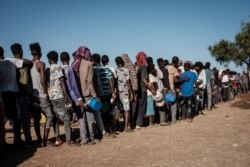The United Nations says that the Ethiopian government is preventing aid from reaching non-government-controlled rural areas in the Tigray region, where most of the province’s 2.3 million people in dire need of assistance are living.
Violent clashes continue in northern Ethiopia’s Tigray region three months after the government launched a military offensive on the regional capital, Mekelle. The U.N. Office for the Coordination of Humanitarian Affairs says humanitarian conditions in the region are alarming and rapidly deteriorating.
It says millions of people are in dire need of food, water and other essential relief and services. However, it says aid workers are unable to reach most of the rural areas in Tigray, where the greatest number of people in need are living.
U.N. officials say insecurity and bureaucratic obstacles are preventing aid workers from accessing those areas. OCHA spokesman Jens Laerke says government clearances needed to move the necessary staff into Tigray have not been received.
"An increasing amount of humanitarian cargo has been mobilized, but without staff and access, it will not reach the people who need it the most, especially in rural areas…Access to the countryside is mostly blocked for both U.N. agencies and NGO’s (non-governmental organizations), and no humanitarian assistance is taking place in non-government-controlled areas," said Laerke.
Laerke notes aid is available for people living in towns along the main roads from Mekelle towards Shire, which are controlled by federal government forces.
He says people in rural areas, where two-thirds of Tigray’s population live, are not so fortunate.
He says economic activity and access to essential services, including electricity, telecommunications, cash, and fuel are largely disrupted. He says hunger reportedly is growing.
"Lack of food in markets is reported, as the conflict broke out during harvest season, leaving crops unharvested," said Laerke. "Key supply routes to Tigray are still cut. And malnutrition among the population was already on the rise because of COVID-19 and the desert locust situation.”
Laerke says more than 70 humanitarian staffers are still waiting for their clearances in the Ethiopian capital, Addis Ababa. He adds they are ready to move into Tigray to resume aid distribution as soon as the government gives them the go-ahead.











